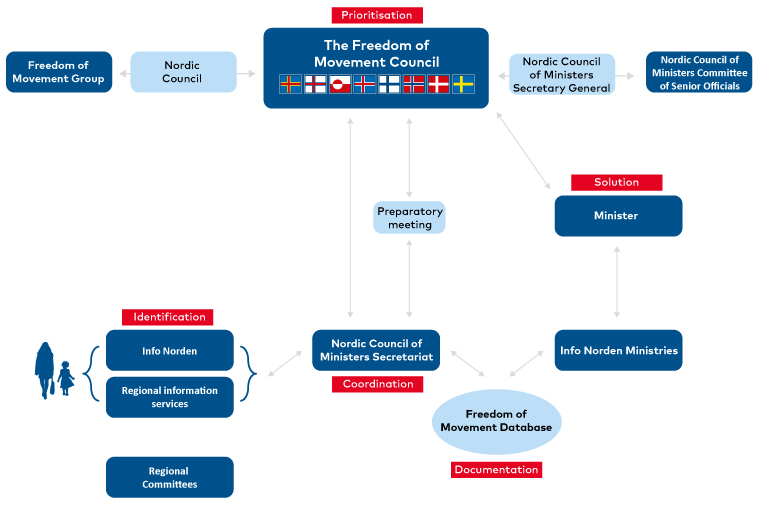Organisation of the work of the Freedom of Movement Council
It is important that the work of the Freedom of Movement Council, both regionally and nationally, is linked to the relevant Nordic Council of Ministers and to the relevant national ministries and parliaments. This is to create transparency and participation in the Nordic work to remove the cross-border obstacles identified by individuals and businesses throughout the Nordic Region.
The illustration shows how the work of the Freedom of Movement Council is organised.

Identification
The information services, Info Norden, Øresunddirekt, Grensetjänsten Norge-Sverige, and Gränstjänsten Sverige-Finland-Norge, are in daily contact with citizens and businesses inquiring about cross-border matters. It is through these interactions that potential cross-border obstacles are often identified. The information services then report descriptions of these obstacles, and in some cases, propose solutions to the Secretariat of the Freedom of Movement Council.
Definition of cross-border obstacles
In the Nordic co-operation regarding freedom of movement, obstacles are “laws, statutory regulations or practices that restrict the mobility of the individual or the ability of businesses to operate across Nordic borders.” The different levels of wages and taxes in the Nordic countries are not cross-border obstacles. However, it is regarded as an obstacle if a person, on account of their mobility, is treated differently to other people in a comparable situation, both in the country of residence and the country of work.
The Freedom of Movement Council also works on issues and challenges that do not fall directly under the above-mentioned definition of obstacles but are considered to hinder intra-Nordic mobility and integration. These efforts include working on specific thematic areas related to mobility and integration, aiming to further enhance seamless movement and cooperation within the Nordic Region.
Documentation
The Secretariat of the Freedom of Movement Council, in collaboration with relevant national departments, processes and assures the quality of the materials received from the information services. These national departments, staffed with experts in the field, play a crucial role in ensuring the accuracy and quality of reported issues. Following this, the cross-border obstacles are documented in the Freedom of Movement Database.
To provide the Freedom of Movement Council members with reliable information for prioritising new cross-border obstacles and addressing previously prioritised cases, it is essential to regularly update the Database's descriptive texts. The Freedom of Movement Council also functions as a critical information resource for the Nordic Council of Ministers' sectors, information services, and the Nordic public. Therefore, maintaining accurate and current descriptions of cross-border obstacles is a fundamental aspect of this comprehensive update process. The database is updated once every two years.
The most up-to-date information on each cross-border obstacle is always available in the Freedom of Movement Database.
Prioritisation of obstacles
To create long-term continuity and structure in the work on cross-border obstacles, each member of the Freedom of Movement Council selects relevant cross-border obstacles to be prioritised in the Council's work. The selection is made based on the cross-border obstacles documented in the Freedom of Movement Database. Members may choose to prioritise certain cross-border obstacles jointly. A crucial aspect for the long-term effectiveness of the work is that when a national member is replaced, the previous priorities are always carried forward by the new member.
Under certain circumstances, e.g., if the matter is urgent or affects many people, it may be possible to prioritise ad-hoc cross-border obstacles that are not yet in the database.
The Secretary General, who is the Nordic Council of Ministers' representative on the Freedom of Movement Council, is responsible for coordinating the work on cross-border obstacles carried out in the relevant ministerial councils. The Nordic Council's representative on the Freedom of Movement Council coordinates the Freedom of Movement Council's work on cross-border obstacles carried out in and through the Nordic Council.
Solution
The Freedom of Movement Council operates under the mandate given by the Nordic prime ministers, emphasising collaboration and open dialogue with departments and authorities responsible for managing the cross-border obstacle.
Each year, the Freedom of Movement annual report includes updates from its members and the relevant departments. In this way, the work on cross-border obstacles becomes transparent, and everyone can follow the process around the prioritised cross-border obstacles.
Efforts persist until a cross-border obstacle is resolved or considered unsolvable by relevant departments or authorities. The Freedom of Movenent Council plays a facilitative role, with actual resolution resting with decision-makers and national authorities in the Nordic countries, the Faroe Islands, Greenland, and Åland through necessary changes in agreements, regulations, or practices.
However, the Freedom of Movement Council can address cross-border obstacles to mobility and growth in the Nordic Region by providing detailed problem analyses, suggesting solutions and, when it is possible, cost analysis.
Coordination
The Nordic Council of Ministers' Secretariat is responsible for coordinating the work of the Freedom of Movement Council. Additionally, the Secretariat coordinates the Freedom of Movement Council's work with the efforts to address cross-border obstacles carried out in the sectors of the Nordic Council of Ministers' Secretariat. Furthermore, the Secretariat collaborates with the Secretariat of the Nordic Council to coordinate the co-operation between The Nordic Council Freedom of Movement Group and the Freedom of Movement Council.
The Secretariat also has a coordinating role regarding the activities of the information services, particularly concerning the co-operation between the information services with the aim of streamlining the work on cross-border obstacles and information.